Cloud Gate 2 presents On the Road for an all-male trio. Three men from Pavel Zuštiak/Palissimo Company perform Endangered Pieces.
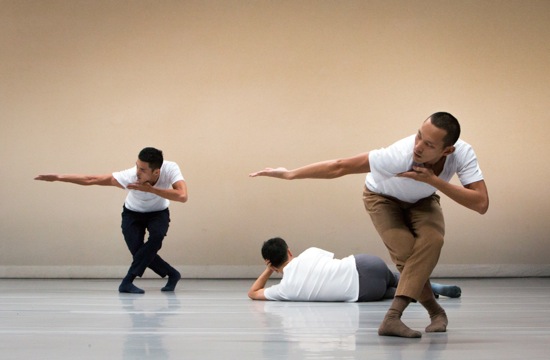
Cloud Gate 2 in Cheng Tsun-lung’s On the Road. (L to R): Chang Chien-Hao, Chiang Pao-Su, Luo Sih-Wei. Photo: Yi-Chun Wu
Three men in a tub. Three Musketeers; The Three Stooges; Chico, Harpo, and Groucho Marx; the three sailors in Jerome Robbins’s Fancy Free. What can they not get up to in the way of adventure, comradeship, and rivalry? A while back, Cheng Tsun-lung, the associate artistic director or Taiwain’s Cloud Gate 2, went on a trip with two other dancers, Chiang Pao-su and Luo Sih-wei. The result of this male-bonding experience, On The Road (2011), winner of a major prize in Taiwan, was performed at the Joyce Theater, with Chiang and Luo joined by Chang Chien-Hao.
Cloud Gate 2 was founded in 1999 by Lin Hwai-min, its current artistic director, and the late Lo Man-fei, but it doesn’t serve as a feeder company for the world-famous Cloud Gate Dance Theatre. Instead, it challenges young choreographers to find their own voices and build a repertory for a small-scale touring group. Having presented a mixed bill at the Joyce in 2012, the reduced company returned with this evening-long work.
The three men are warming up as the audience arrives. Chang is tall and rangy, Chiang short and sturdy. Lo, the silkiest mover, fits between them when they line up in a far corner in order of height. The house lights are still on when they progress across the back of the stage with perfectly synchronized little prances that gradually speed up. A plucked instrument begins to sound in Lin Fang-yi’s selection of traditional Asian music. On the backdrop, a projection (designed by Ethan Wang) shows what could be a brooding sky or gray-blue water.
Cheng’s choreography is like a compilation of sights and sounds along the journey. Sometimes the men’s steps suggest trekking. Sometimes they pause and stare into the distance. When one stands behind another, and they convey the image of a many-armed god like Avalokitesvara, is it because they have just passed a temple? When they undulate their arms and shoulders and curl their wrists, have they dropped in on a dance in a village festival? Occasionally, they hold up their hands like paws; did they just sight a squirrel? If one man crawls on his belly, are low-hanging branches the issue? Often two or all three dance in unison; on occasion, one manipulates another. They fight (or practice martial arts, or take in a street performance of Chinese opera, or. . . ?). Do I imagine a monkey? They play games, like getting stuck to one another.
Shen Po-hong’s lighting changes to indicate the changing hours. The behavior of the three is quite casual. Sometimes, they just walk to a new spot on the white-floored stage in order to begin a new activity. At one point, Chiang lies on his back, with his legs bent; Lo sits on Chiang’s upraised knees and looks questioningly at Chang: what now? Whether performing alone, or paired, or all together, these dancers are compelling to watch—as adept at delivering small, telling gestures and looks as they are at printing bold, clear-edged, resilient movement on the space. The variegated music matches their rhythms, whether directly or indirectly.
You can glimpse what appear to be tattoos under the men’s white t-shirts, but the designs are inked and begin to seep through the shirts (body painting concept by He Jia-sing). Maybe that’s one reason that the performers stop after about 45 minutes of traveling and, in a corner of the stage, drink water, towel off, and replace their clothing with fresh white shirts and pants that duplicate costumer Lin Bing-hao’s original color scheme (gray pants for Chiang, beige for Lo, black for Chang). Chang wipes a patch of sweat off the floor.
There are mysteries. Why does Chiang pull his t-shirt up to mask his face and inch sideways along, during a dimly lit sequence that’s accompanied by Tom Waits’s gravelly voice singing, “But no one puts flowers/On a flower’s grave”? Perhaps dreams are a part of this trek, as well as thoughts abour the transience of life and its possible renewal.
Cultural differences may hinder my perception of On the Road, but certain resonances come through vividly. They have to do with friendship and shared adventures and a robust sense of bodies at work and play.
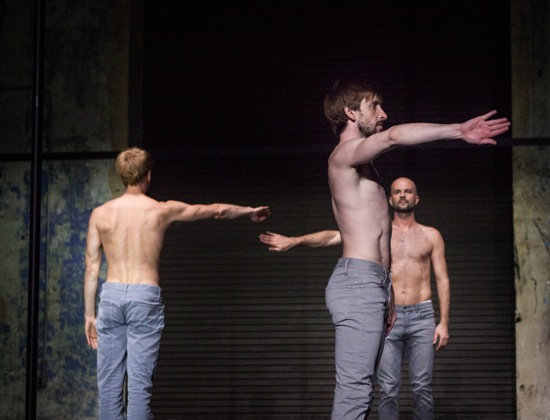
(L to R): Matthew Rogers, Jaro Viňarský, and Pavel Zuštiak of Palissimo in Zuštiak’s Endangered Pieces. Photo: Yi-Chun Wu
Pavel Zuštiak/Palissimo Company’s new Endangered Pieces also features three men, but this is a work that defies easy interpretations and puts the audience somewhat on the spot. As with On the Road, the front curtain of the Abrons Arts Center’s stage is open when the audience enters. Our first glimpse of Zuštiak’s world is a grim one. Three long iron poles on round bases are tipped over on their sides; a ghost light with its bare bulb stands front and center; the back wall, with its smudged and chipped paint, is visible, along with the black metal door that pulls down to conceal an alcove that may be part of a loading dock. Horizontal pipes of the kind made to hold lights or a curtain hang low over the area. To one side of the stage and toward the back, a naked man is lying, face up, immobile.
The preparation is part of the performance. The metal door is pulled up to reveal the alcove, glowing in Joe Levasseur’s lighting. Against its rear wall, lengths of board (maybe 1 x 3s) are stacked vertically. The arrangement resembles a miniature mockup of a modern city. Zuštiak unplugs the ghost light, coils its wire, and wheels it offstage. Via gestures, Matthew Rogers has the backstage crew let down the red velvet teaser so he can check it; then it is flown back up. The poles are stood upright. As I remember, musicians Christian Frederickson and Bobby McElver have not yet introduced their sound accompaniment.
The first task of the evening involves the body on the floor. It belongs to that extraordinary actor-dancer Jaro Viňarský (he just won a Bessie for his outstanding performance in Zuštiak’s The Painted Bird Trilogy/Bastard). He is inert but not stiff. Gravely—even courteously— Zuštiak and Rogers stand him upright, tip him over, turn him upright again. Over the next few minutes they will try all manner of strategies. At first, you think you know what their intent is: they want Viňarský upright and on his own. Every time they almost manage it, he slips to the floor again. But what good does it do to roll over him, sling him across Rogers’s shoulders, press him up against the back wall? At the end of this sequence, Zuštiak squats with his back against the wall, and Viňarský slides down to lie across his lap—a pietà, but with the Christ figure’s butt turned to the viewers. Rogers then maneuvers Viňarský into a cruciform position.
After Rogers and Zuštiak leave the stage in a matter-of-fact way, Viňarský pulls on some clothes while an unseen voice (it is Paul Cooper’s) addresses us. “Imagine an empty space.” “Imagine a cliff next to an ocean.” “Imagine the last man.” And then, as Viňarský walks to the front of the stage and looks at us, “Here he is. He is the only one. The only him.” A few hands clap. This woebegone hero stands on a chair and hammers mechanically on the door at the back. Then, in a careful order, he removes items of clothing and puts them on again. A pipsqueak of a melody starts up. “Where is he going?” asks the voice. He is leaning against the proscenium arch, rubbing his crotch; he is pointing out a door. The house lights come on.
All the questions about Viňarský’s character might be ours. What is he doing? What does he want? Events in this world are out of synch with one another. After Viňarský leaves the stage, the boards in the alcove begin to topple until the “city” is rubble. The lights dim. The black metal door comes down. A high melody is heard. The red velvet front curtain descends.
Now it is Rogers’s turn to be the mystifying man alone in the world. He comes through the red curtains into a spotlight, and immediately there are queries. This time the unseen interrogator is a woman (Tara Frederickson). Rogers smile at us and touches one ear. “What does he mean by that?” asks the voice. Search me. He executes some big jumps, and says “The past, the present, and the future walked into a bar.” After a pause, he adds, “It was tense.” He also starts to recite the 23rd Psalm. Little beaded footlights come on. “Can he build a logic in this location?” asks the vexing voice. It’s amazing how Levasseur’s lights suddenly change the look of Rogers’s body, sculpting his chest muscles and abs even as he seems to be stooping under a burden.
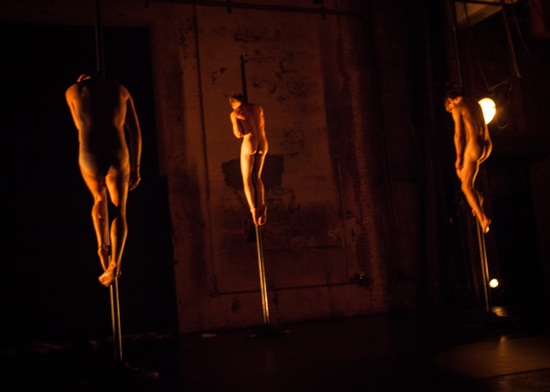
Suspended (L to R): Pavel Zuštiak, Matthew Rogers, Jaro Viňarský in Endangered Pieces. Photo: Yi-Chun Wu
Recovering from a roar of sound, we contemplate the red curtain for a while. It opens on the most startling sight in Endangered Pieces. The three men, now naked, have climbed the poles and, backs to us, are gripping them with their legs and arms. Their necks are bent forward so that they appear to be headless. Anyone with a Christian upbringing or a degree in art history is liable to think of Jesus and the two thieves crucified along with him. A wash of chords swells and disappears as the three slowly, slowly, slowly slide down the poles and crouch in red light.
Endangered Pieces shows a world destroying itself. A sequence in which the men, now clothed, semaphore in different directions, suggests that they’re signaling numbly through the flames, or turning like weather vanes in a confused wind. In a solo, Zuštiak stares toward the audience as if we were his mirror; he strokes his head, knocks it with his fists. He flutters his hands so fast that they blur.
The men’s last act is to rebuild the city. They aren’t very successful. They lay neat tracks with the fallen boards—tracks to nowhere. They unmake what others of them have made. Viňarský creates an arch and stands on it, then tries to remove one crucial board without destroying the structure. Rogers, sitting, gradually incorporates himself into the structure he is making. Should he move, the whole thing will crumble.
The renovation strategies become increasingly pointless. What has Zuštiak achieved by balancing a board on the back of his neck? When Rogers flips one, and it flies through the air and crashes down, the end seems near. Viňarský is unable to make five boards align. One by one, the men leave the rubble. The curtain descends at an excruciatingly slow pace.
Almost slowly enough to convey how gradually, how inexorably we humans are destroying our world.

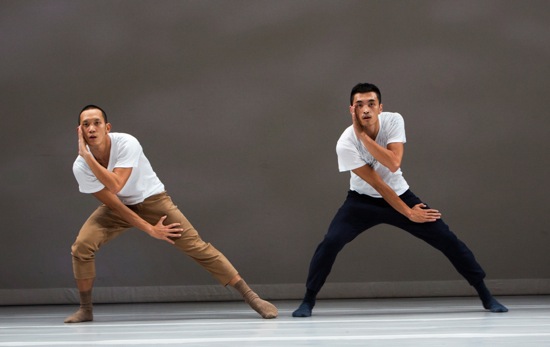
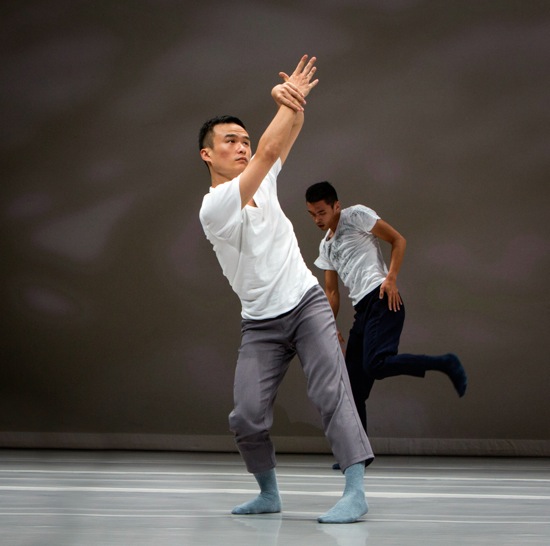


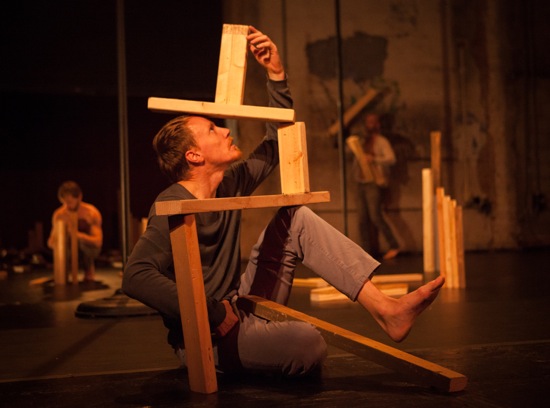
Two more concerts I would have loved to see. Just one small note: In the paragraph starting with “Now it is Rogers’ turn. . ” there should probably be a “be” after “to” and before “the.”
I posted Carol’s comment, rather than simply thanking her via e-mail and making the necessary correction. Why? To show how perilous it can be to publish without the luxury of editor’s eagle eye and to express publicly how grateful I am for eagle-eyed readers.